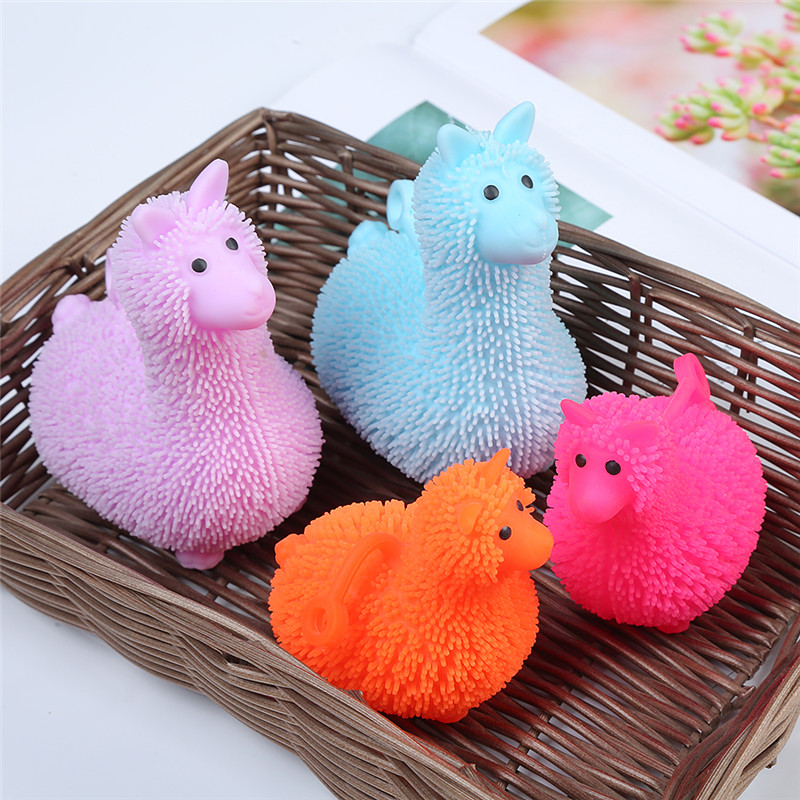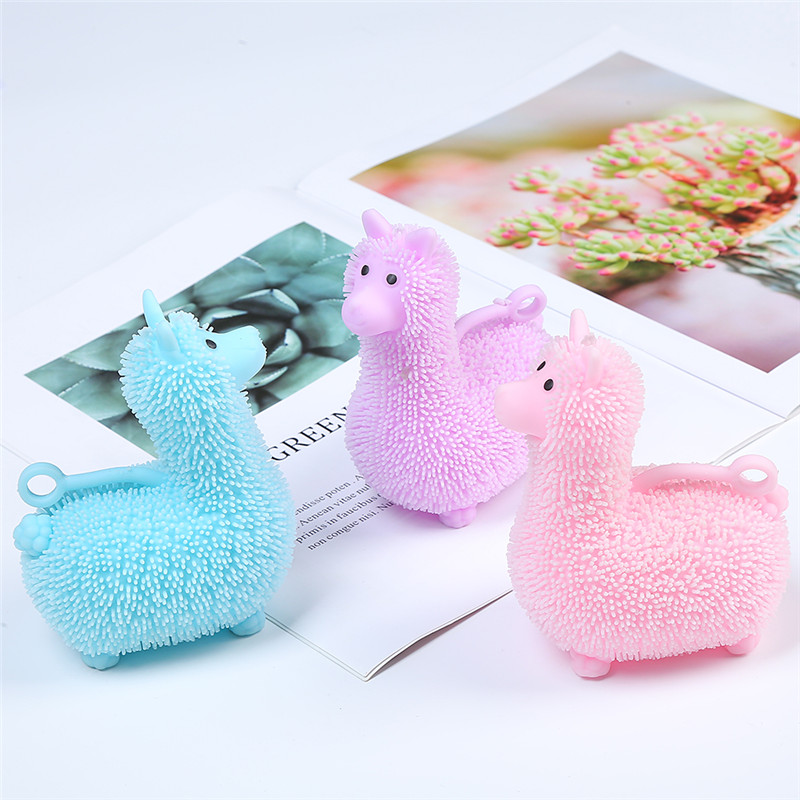What types of stress-relieving toys are there?
Anxiety and stress have long been a daily companion for professionals, students, and even housewives. Stress-relieving toys, thanks to their portability, fun nature, and lack of side effects, have gradually become a global “emotional first aid tool.” Sales of soft squishy toys, stress-relieving balls, and stretching toys, in particular, have continued to soar in cross-border e-commerce, as more and more consumers are turning to these small gadgets to relieve negative emotions.
But did you know? Stress-relieving toys aren’t limited to just squishy toys. Stress-relieving toys with different materials and interactive methods cater to a wide range of needs—from office workers seeking a quick way to relieve stress, to students seeking immersive relaxation, to those requiring hand rehabilitation training—there’s a toy that’s right for everyone. Today, we’ll systematically review the most popular stress-relieving toy types globally to help you understand the product landscape and provide consumers with a more accurate selection guide.
First. Soft Squishies: “Slow Healing at Your Fingertips,” Perfect for Daily Relaxation
As a “national-level” stress-relieving toy, soft squishies, with their bouncy feel and adorable designs, have become a go-to “pocket de-stressing gadget” for many. The core advantage of this type of toy lies in its “slow rebound + shapeability.” Through finger pressure and kneading, they gradually relax tense nerves, making them ideal for use during fragmented time.
1. Slow Rebound Squishies
This is the most classic type of squishy toy, typically made of polyurethane foam. After being pressed, they slowly return to their original shape, providing both visual and tactile pleasure. Common designs include food (such as strawberries, bread, and sushi), animals (such as cat paws and rabbit faces), and cartoon characters. With vibrant colors and high fidelity, they offer both stress relief and decorative appeal.
Suitable for: Students, office workers, and children (choose eco-friendly materials).
Use scenarios: Knead it in your palm during breaks in class or at work, or use it as a desk ornament to soothe your annoyance.
2. Silicone Squishies
Unlike slow-rebound materials, silicone squishies prioritize softness and cleanability. High-quality silicone is non-toxic and odorless, feels as delicate as baby skin, and rebounds quickly when pressed, making it ideal for those who appreciate instant feedback. Some squishies also feature a sound-generating mechanism, producing a gentle “pop” sound when squeezed, further enhancing the de-stressing effect.
Advantages: Waterproof and drop-resistant, washable and reusable, perfect for families with children or those who frequently travel.
Popular styles: Silicone cloud, silicone bun, and silicone keychain with a lanyard (can be attached to a bag for instant de-stressing).
Second, Compression-Based Stress Relief: The Magic of Repetitive Motions, Specifically Designed to Treat Anxiety and Inattention
The core principle of this type of toy is to help users focus and redirect negative emotions through repetitive compression. Whether you need to quickly release stress or stabilize your mind in a tense situation (such as before an exam or interview), compression-based stress relief toys are effective.
1. Stress Balls
Stress balls are the “forefathers” of compression-based toys and a perennial favorite in the cross-border market. Traditional stress relief balls are mostly made of sponge, filled with soft particles or liquid. When squeezed, they create a noticeable “resistance,” making them ideal for relieving stress through manual exertion. The recently popular “gel-based stress relief balls” feature an upgraded material—transparent gel coated with sequins, glitter, or small toys. When pressed, the fluid inside can be seen, maximizing the visual relief effect.
Subcategories:
Granule-filled stress relief balls: They offer a rich tactile feel and are suitable for those with sensitive hands;
Luminous stress relief balls: Glow when pressed in the dark, adding to the fun;
Scented stress relief balls: Scented with natural essential oils (such as lavender and lemon), they combine olfactory therapy for a more relaxing effect.
2. Bubble Pop It
The “Rat Killer” toy, which became a hit in 2020, falls into this category. It’s essentially a silicone plate with raised bubbles. Users press each bubble, hearing a “pop” sound and feeling the popping back. The advantages of this toy lie in its simple rules and infinite replayability, allowing adults and children alike to gain a sense of security and satisfaction through repeated pressing.
Variants:
Shaped bubble boards: Shaped into chessboards, fruits, and animals for added interactivity;
Portable bubble stickers: Attach to phone cases and notebooks for on-the-go stress relief;
Luminous bubble boards: Perfect for nighttime use, perfect for relaxing before bed.
Third. Stretch and Twist Toys: “Relieves Body Tension” – Suitable for those with hand muscle tension
If you frequently spend long hours on a computer or phone, causing stiffness and soreness in your hands, stretch and twist toys are a great choice. These toys use stretching, twisting, and wrapping movements to help relax your hand muscles while distracting your mind from stress.
1. Stretchy Noodles
These noodles are typically made of TPR (thermoplastic rubber), a soft yet highly resilient material. They can be stretched to several times their original length and quickly return to their original shape after release. Some noodles also feature a textured design, creating a bumpy feel when stretched, further stimulating the hand nerves and relieving muscle tension.
Use scenarios: After long hours of typing, stretching a few noodles can effectively relax your wrists and finger joints. Playing with them discreetly under the table during meetings can also help prevent distraction.
2. Twist Stress Toys
These toys are mostly cylindrical or bar-shaped, with a soft silicone outer layer and a twistable metal wire inner layer. Users can twist them into various shapes (such as spirals and circles) and bend them repeatedly to release stress through “changing shapes.” Some stress toys also feature a magnetic design, allowing the two sections to snap together, increasing playtime versatility.
Advantages: They not only relieve stress but also improve hand coordination, making them suitable for children and those requiring hand rehabilitation.
Fourth. Immersive Stress Relief: “A sense of ritual focused on the present moment” suitable for deep relaxation
If you’re looking for a moment of complete immersion rather than just a burst of stress relief, then immersive stress relief toys are a better choice. These toys typically require users to invest a certain amount of time and attention, achieving a sense of accomplishment by completing specific actions, thereby achieving a deep relaxation effect.
1. Kinetic Sand
Also known as “kinetic sand,” this is a special type of sand made from a mixture of natural sand and polymer materials. It retains the fluidity of sand while allowing for free shaping (such as building castles or shaping figures). It’s also non-sticky, non-scattering, and easy to clean. When playing with stress-relieving sand, users focus on their hand movements and the changing shapes of the sand. This sense of focus can quickly block out external distractions and calm the mind.
Suitable for: Playing for 10-15 minutes before bed can help relieve a day’s fatigue; children can use it to develop their hands-on skills and creativity.
2. Stress Puzzles & Mazes
Unlike traditional puzzles, stress-relieving puzzles are often designed to be more therapeutic—for example, wooden or soft foam puzzles. They don’t require worrying about missing pieces and offer a softer feel. Stress-relieving mazes, on the other hand, are often 3D designs. Users must tilt and rotate the maze to get a ball from the starting point to the end point, requiring focused attention and helping to distract themselves from anxiety. Advantages: Suitable for those who need a slow-paced relaxation experience, such as high-pressure professionals and menopausal women. By completing puzzles or mazes, they gain a sense of control and accomplishment.
Fifth. Special Function: “Targeted Solutions,” Covering Niche but Precise Stress-Relief Scenario
In addition to the mainstream categories mentioned above, some stress-relief toys are designed for specific groups or scenarios. While these targets a relatively niche audience, they enjoy steady demand in the cross-border market.
1. Chewable Stress Toys
Primarily designed for people with Attention Deficit Hyperactivity Disorder (ADHD), children with autism, or adults who enjoy chewing, these toys are typically made of food-grade silicone and are safe to chew. The chewing action helps users relieve stress and focus, while also helping to prevent unhealthy habits like nail biting and pen chewing.
Popular Styles: Silicone chew necklaces and bracelets, combining decorative and practical features. 2. Temperature-Sensitive Toys
These toys change color or texture with temperature. For example, a “cold-sensitive stress relief ball” feels cool when refrigerated, making it ideal for use in hot weather or when feeling irritated. A “warm-sensitive silicone mat” changes color from white to color upon contact with body temperature, creating a visually appealing experience and helping to relieve tension.
Suitable for: Summer office use, before exams, before presentations, and other situations where you need to calm down quickly.
How to Choose the Right Stress Relief Toy for You? Three Key Criteria
After reviewing the above categories, you might be wondering: With so many options, which one should I choose? The key to choosing a stress relief toy is to “match it to your needs.” You can consider the following three criteria:
Type of Stress: If you experience “sudden bursts of stress” (such as after an argument or criticism), choose a compression-based toy (a stress relief ball or bubble board) to release your emotions through quick movements. If you experience “long-term, accumulated anxiety” (such as preparing for exams or working overtime), choose an immersive toy (stress relief sand or puzzles) to relieve fatigue through focused focus. Usage scenarios: Choose silent models (such as silicone squishies and stress relief sticks) for office use to avoid disturbing others; choose portable models (such as lanyard squishies and mini stress relief balls) for on-the-go; and choose immersive models (stress relief sand and 3D mazes) for home use to enjoy exclusive relaxation time.
Targeted audiences: Choose eco-friendly, non-toxic, and drop-resistant models (such as silicone squishies and bubble boards) for children; choose aesthetically pleasing and practical models (such as slow-rebound squishies and scented stress relief balls) for adults; and choose targeted functional models (such as chew toys and magnetic stress relief sticks) for special needs (such as those with ADHD).
Post time: Oct-10-2025

